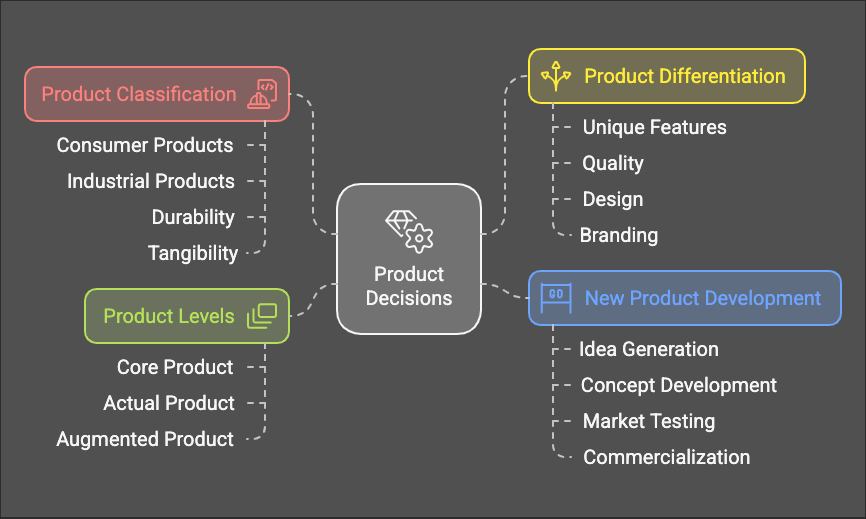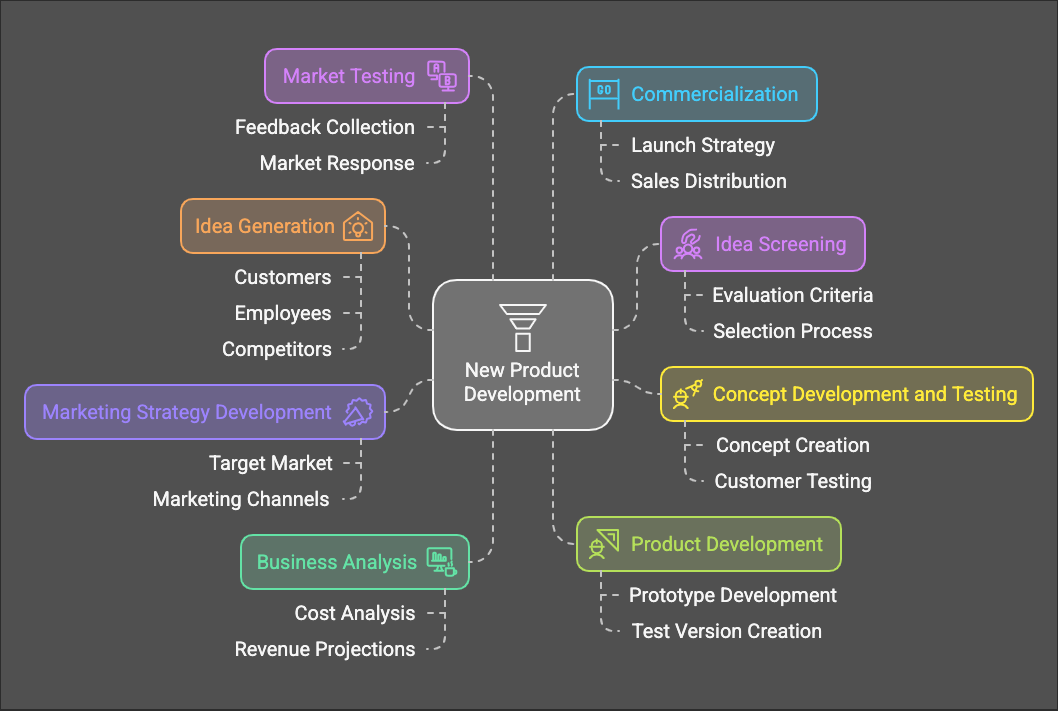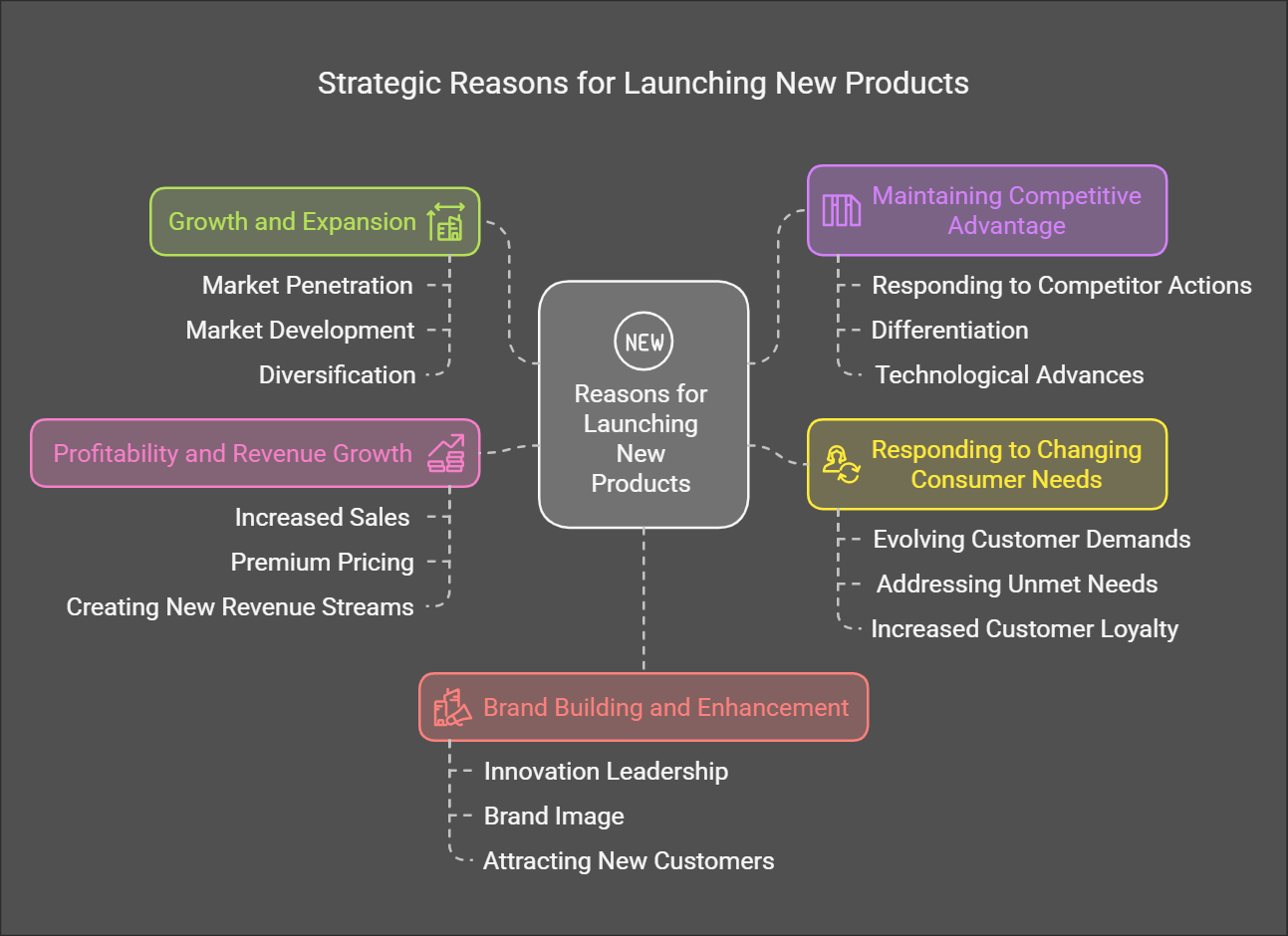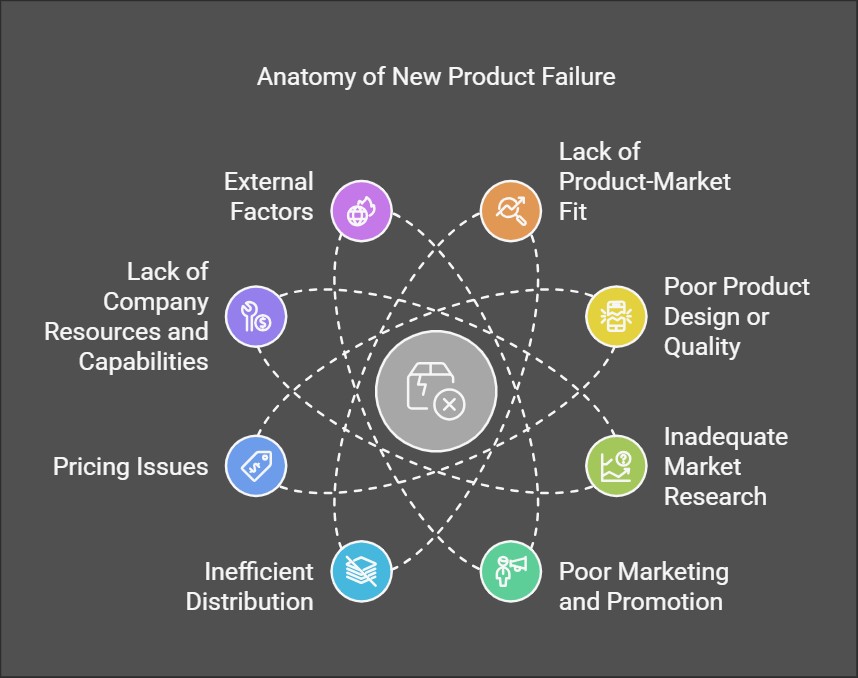Define Setting Product Strategy
Unit III: Product Decisions
This unit explores the exciting world of products and how companies make smart choices to succeed.
Setting Product Strategy
# Product Classification
ProductsWhy can be grouped in different ways to help businesses understand their market and make better decisions. Here are a few common classifications:Classify?
- Understand Consumer Behavior: How people search, evaluate, and buy.
- Target Marketing: Tailor messages to specific needs.
- Set Prices: Reflect perceived value and buying habits.
- Distribution: Get products where they need to be.
-
Develop New Products:
TheseMeetaremarketproductsdemandsboughteffectively. -
individualsManage Inventory: Stock the right amount at the right time.
I. Consumer Goods: Bought for personal use.
-
yourA.
favoriteConveniencesnacks,Goods:clothes,Graborandgadgets.go! Low effort, frequent purchase.-
1. Staples: Essentials always on hand.
- Groceries: Milk, bread, eggs
- Household: Toilet paper, cleaning supplies
- Personal care: Soap, shampoo
-
Industrial2.Products:Impulse:TheseSpur-of-the-momentarebuys.products- Candy,
bygum,businessesmagazinestoatmakecheckout - Small
productstoys,orphonerunaccessories
usedothertheiroperations. Examples include raw materials, machinery, and office supplies. - Candy,
-
Durability:3. Emergency:ProductsUrgentcanneeds,bepricedurableless(long-lasting,important.like- Umbrellas in a
refrigerator)storm - Over-the-counter
non-durablemedicine - Batteries
quickly, likeduring achocolatepowerbar).outage
or(consumed - Umbrellas in a
-
1. Staples: Essentials always on hand.
-
B. Shopping Goods: More thought, comparison shopping.
-
Examples:
- Clothing: Style, fit, quality matter
- Furniture: Durability, looks, comfort
- Electronics: Research brands, features, reviews
-
Examples:
-
C. Specialty Goods: Unique, strong brands, loyal customers.
-
Examples:
- Luxury cars: Ferrari, Lamborghini
- Designer clothes: Gucci, Chanel
- High-end electronics: Top audio, cameras
- Collectibles: Rare stamps, coins, art
-
Examples:
-
D. Unsought Goods: Need to create awareness and need.
-
Examples:
- Life insurance: Sold through agents
- Funeral services: Pre-need arrangements
- Blood donations: Campaigns to encourage giving
- New inventions: Solving problems people don't know they have
-
Examples:
II. Industrial Goods: Bought for business use.
-
A. Materials and Parts: Building blocks of other products.
-
1. Raw Materials: Unprocessed, from nature.
- Agricultural: Wheat, cotton
- Minerals: Iron ore, crude oil
- Timber
-
Tangibility:2. Manufactured:ProductsProcessed,canreadybefortangibleassembly.(physical- Components:
youEngines,cantires - Processed
ormaterials:intangibleSteel,(servicesplastics
goodstouch)likea - Components:
haircutor -
1. Raw Materials: Unprocessed, from nature.
-
doctor'sB.
visit).Capital Goods: Big investments, aid production.-
Examples:
- Installations: Buildings, factories, heavy machinery
- Equipment: Computers, servers, vehicles, tools
-
Examples:
-
C. Supplies and Services: Support operations, not in final product.
-
Examples:
- Operating supplies: Office supplies, cleaning supplies
- Maintenance and repair: Keeping things running
- Business services: Consulting, legal, accounting
-
Examples:
Product Levels
A product is more than just the physical item or service—it has multiple levels that satisfy the customer’s needs. These five levels, introduced by Philip Kotler, are:
1. Core Product
The core product is the fundamental benefit or value that the customer is buying.
- It answers the question: What is the customer really buying?
- It is not a physical product but the basic need or solution the product fulfills.
Examples:
- A smartphone’s core product is communication and connectivity.
- A hotel room’s core product is providing rest and shelter.
2. Basic Product
The basic product refers to the physical or tangible product that provides the core benefit.
- It includes the essential components and features that make the product functional.
Examples:
- For a smartphone: The device itself with its touchscreen, battery, and calling features.
- For a hotel room: The bed, bathroom, and lighting.
3. Expected Product
The expected product encompasses all the attributes or features that customers typically expect when they buy the product.
- These are the minimum requirements that the product must meet to satisfy customer expectations.
Examples:
- A smartphone: Customers expect good battery life, a clear screen, and basic apps like a camera and messaging.
- A hotel room: Customers expect clean sheets, a comfortable mattress, hot water, and basic amenities like soap and towels.
4. Augmented Product
The augmented product includes additional features, services, or benefits that differentiate the product from competitors.
- It goes beyond customer expectations to create added value and improve customer satisfaction.
- This is a key area for product differentiation.
Examples:
- A smartphone: Free cloud storage, extended warranties, customer service, or pre-installed premium apps.
- A hotel room: Free Wi-Fi, complimentary breakfast, swimming pool access, or personalized services like concierge assistance.
5. Potential Product
The potential product represents all future improvements or innovations that could be made to enhance the product and satisfy customers further.
- It is about what the product could become to meet evolving customer needs or take advantage of new technology.
Examples:
- A smartphone: Future updates like foldable screens, enhanced AI assistants, or holographic displays.
- A hotel room: Virtual reality tours, automated room service using robots, or AI-powered guest preferences.
Summary Table for Better Understanding:
| Level | Definition | Example (Smartphone) | Example (Hotel Room) |
|---|---|---|---|
| Core Product | The fundamental benefit or solution the product provides. | Communication and connectivity. | Rest and shelter. |
| Basic Product | The tangible product providing the core benefit. | The phone itself, with basic hardware. | Bed, bathroom, and lighting. |
| Expected Product | The minimum features or attributes expected by customers. | Touchscreen, good battery life, basic apps. | Clean sheets, hot water, soap, towels. |
| Augmented Product | Additional features that add value and differentiate the product. | Free cloud storage, extended warranties. | Free Wi-Fi, complimentary breakfast. |
| Potential Product | Future improvements and innovations. | Foldable screens, holographic displays. | Automated room service, VR experiences. |
Importance of Understanding Product Levels:
- Customer Satisfaction: Recognizing these levels helps companies meet and exceed customer expectations.
- Differentiation: By focusing on the augmented and potential levels, companies can stand out in competitive markets.
- Innovation: Considering the potential product encourages businesses to anticipate customer needs and stay ahead of industry trends.
Product and Services Differentiation
In a crowded market, standing out is key. Companies differentiate their products and services by:
- Unique features: Offering something special that competitors don't have.
- Quality: Building a reputation for superior quality.
- Design: Creating an appealing and functional design.
- Branding: Building a strong brand identity that resonates with customers.
New Product Development
Stages of New Product Development
Bringing a new product to life is a journey with several stages:
- Idea Generation: Coming up with new product ideas from various sources (customers, employees, competitors, etc.).
- Idea Screening: Evaluating ideas and selecting the most promising ones.
- Concept Development and Testing: Creating a detailed concept and testing it with potential customers.
- Marketing Strategy Development: Developing a plan to market the new product.
- Business Analysis: Evaluating the financial viability of the new product.
- Product Development: Creating a prototype or a test version of the product.
- Market Testing: Introducing the product in a limited market to gather feedback.
-
Commercialization:Product Launch: Launching the product to the full market.
Categories of New Products
- New-to-the-world products: Completely new inventions that create a whole new market.
- New product lines: Products that allow a company to enter an existing market for the first time.
- Additions to existing product lines: New products that supplement a company's existing product lines.
- Improvements and revisions of existing products: Making existing products better.
- Repositioned products: Existing products targeted at new markets or segments.
- Cost reductions: New products that provide similar performance at a lower price.
Reasons for Launching New Products & Causes of Failure
According to Philip Kotler's "Marketing Management," launching new products is vital for a company's growth and survival. However, it's also a risky endeavor. Let's explore the reasons for launching new products and the common causes of failure, drawing insights from Kotler's work.
Reasons for Launching New Products
Kotler emphasizes that continuous innovation is crucial for a company to remain competitive and relevant in the market. Here are the main reasons companies launch new products:
-
Growth and Expansion:
- Market Penetration: New products can help a company capture a larger share of an existing market. This can be achieved by offering variations of existing products or by targeting new customer segments within that market. (Kotler discusses market penetration strategies extensively).
- Market Development: New products can enable a company to enter entirely new markets or geographic regions. (Kotler discusses market expansion via market development).
- Diversification: New products can allow a company to move into entirely new industries, reducing reliance on a single market. (Kotler emphasizes diversification as a growth strategy.)
-
Maintaining Competitive Advantage:
- Responding to Competitor Actions: When competitors launch new products, a company needs to respond to maintain its position or lose market share. (Kotler discusses competitive strategies in detail).
- Differentiation: New products can differentiate a company from its rivals, making it more appealing to consumers. (Kotler highlights the importance of differentiation and positioning).
- Technological Advances: Companies may launch new products to capitalize on emerging technologies and offer cutting-edge solutions. (Kotler stresses the importance of innovation and staying abreast of technological trends).
-
Responding to Changing Consumer Needs and Preferences:
- Evolving Customer Demands: As consumer preferences shift, companies must innovate to meet those changes and ensure continued relevance. (Kotler discusses the importance of understanding consumer behavior and market research.)
- Addressing unmet needs: New products can fulfill needs that haven't been adequately addressed by existing products or services.
- Increased Customer Loyalty: Successfully launching products that meet the changing needs of their consumers can increase customer loyalty and brand advocacy.
-
Profitability and Revenue Growth:
- Increased Sales: New products, especially successful ones, contribute directly to revenue growth and profitability.
- Premium Pricing: Innovative or high-quality new products may allow a company to command a higher price point, improving profit margins.
- Creating New Revenue Streams: Diversifying product offerings allows companies to create multiple revenue streams reducing reliance on the existing product line.
-
Brand Building and Enhancement:
- Innovation Leadership: Launching new products positions a company as innovative and forward-thinking, attracting customers who value such qualities.
- Brand Image: Successfully launching products that are relevant to the changing landscape builds a strong brand image.
- Attracting New Customers: Successful new products can bring in new customers who may be attracted to the new offerings.
Reasons for New Product Failure
Despite the potential rewards, many new products fail. Kotler outlines several reasons why:
-
Lack of Product-Market Fit:
- Misunderstanding Customer Needs: The product doesn't solve a genuine customer problem or address a real need. (Kotler underscores the need for thorough market research and understanding customer needs.)
- Poor Value Proposition: The product doesn't offer sufficient benefits compared to existing alternatives or is overpriced. (Kotler discusses the importance of crafting a strong value proposition).
- Incorrect Targeting: The product is not targeted at the right customer segment.
-
Poor Product Design or Quality:
- Technical Flaws: The product doesn't function as intended or has significant flaws or quality issues.
- Poor User Experience: The product is difficult to use or lacks essential features that enhance user experience.
- Lack of Thorough Testing: Insufficient testing and quality assurance during product development.
-
Inadequate Market Research:
- Insufficient Market Analysis: Companies may launch products based on assumptions rather than data, or they may misunderstand the competitive landscape.
- Failing to Assess Demand: Launching products that lack sufficient market demand or those that are not relevant. (Kotler stresses the need for proper market research to understand demand, competition, etc.)
-
Poor Marketing and Promotion:
- Ineffective Communication: The value proposition is not clearly communicated to the target market.
- Insufficient Budget: The company doesn't invest enough resources in marketing and promotion to generate awareness and sales.
- Incorrect Marketing Channels: The product is not promoted through the right channels to reach target audiences.
-
Inefficient Distribution:
- Limited Availability: If customers can't find the product, they can't buy it.
- Poor Logistics: Issues with supply chain, distribution, or transportation can lead to customer dissatisfaction.
-
Pricing Issues:
- Too Expensive: The price is too high for the value offered, deterring potential customers.
- Too Low: The price may be too low to generate sufficient profit or may convey a perception of low quality. (Kotler emphasizes the need for strategic pricing decisions).
-
Lack of Company Resources and Capabilities:
- Insufficient Expertise: Companies may not have the required expertise to develop, market, or distribute the product effectively.
- Inadequate Financial Support: The company doesn't allocate enough financial resources to support product development and launch.
-
External Factors:
- Changes in the Economy: Economic downturns or shifts in consumer spending can impact the success of a new product.
- Technological Changes: Technological advancements can make products obsolete or less appealing.
- Competitive Actions: Aggressive moves by competitors can hinder the success of a new product.




